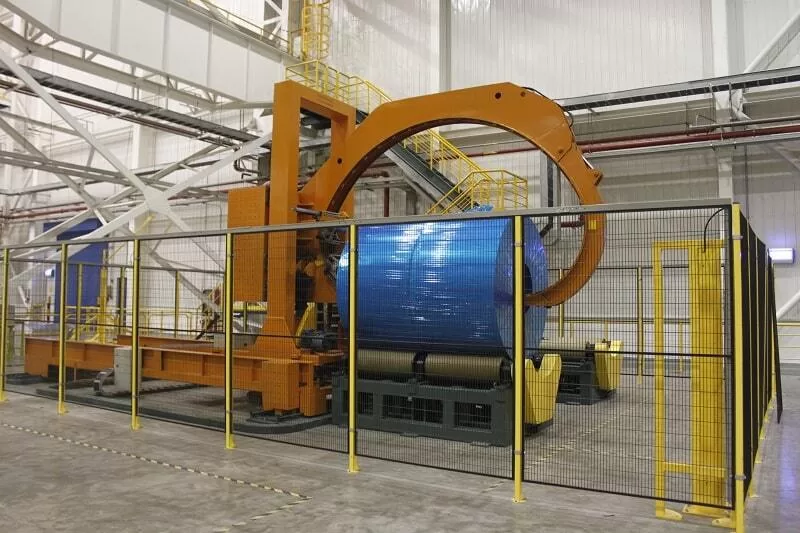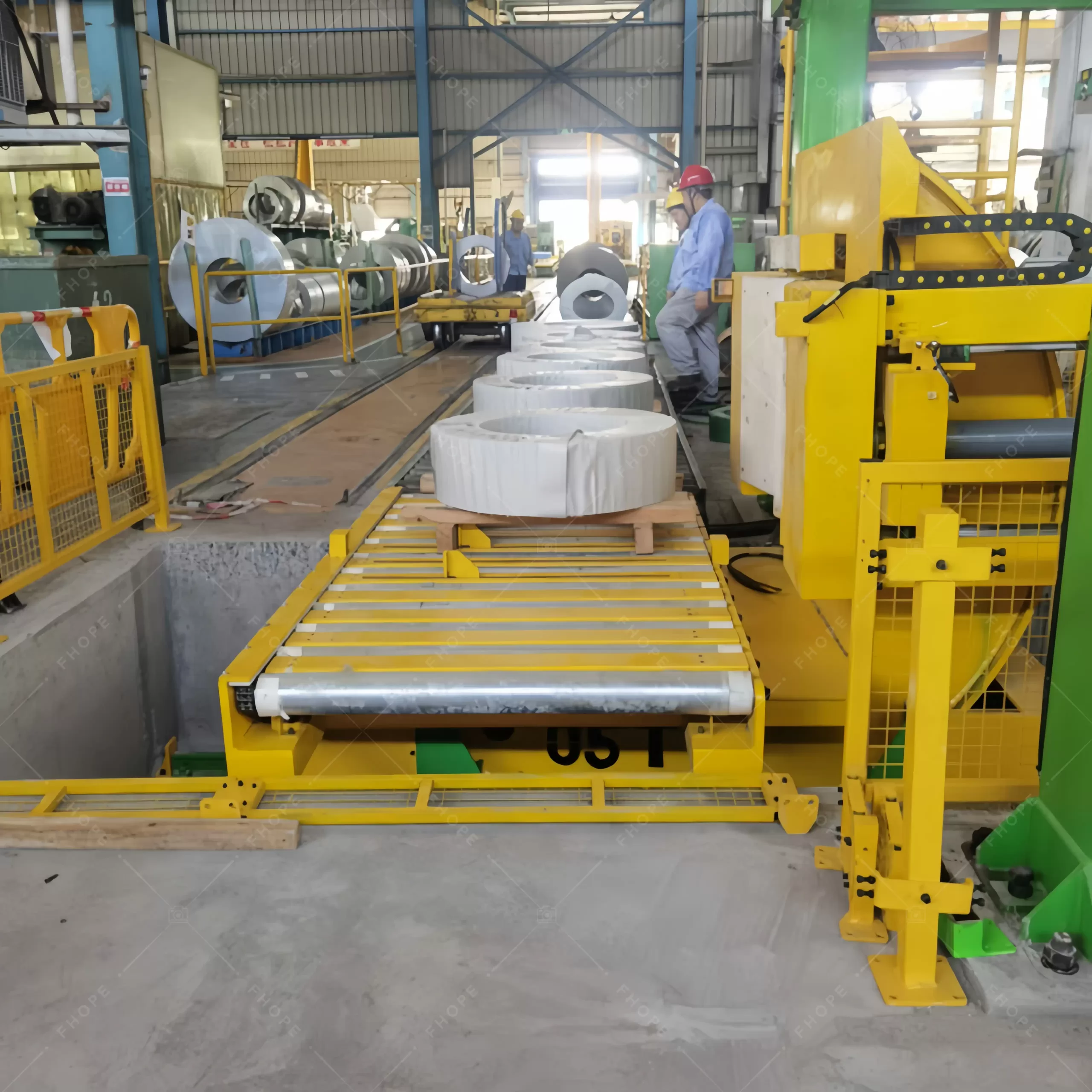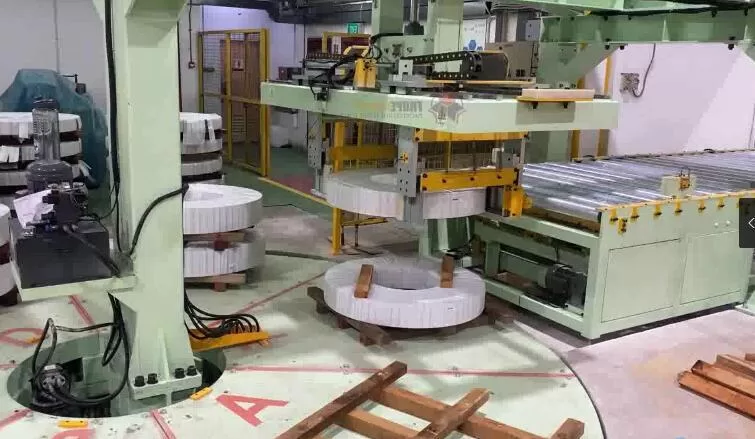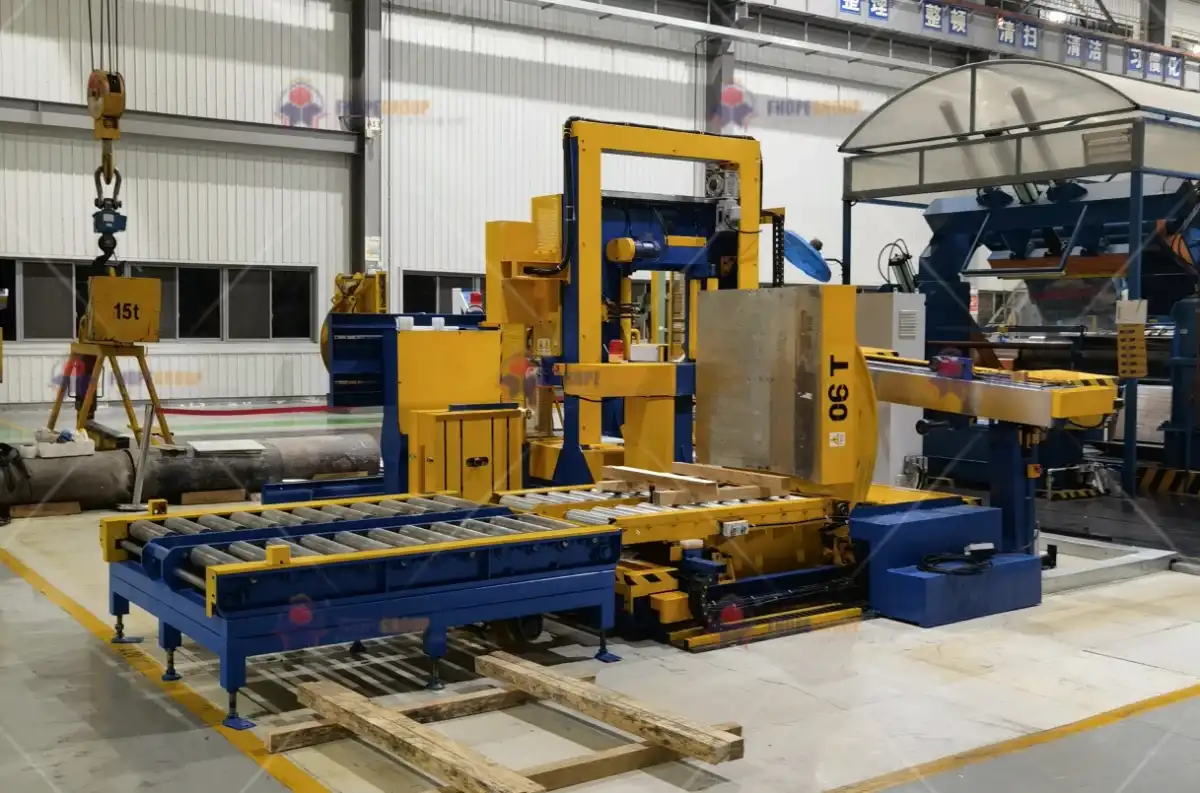Finding the right equipment for your steel mill is a constant challenge. For Italian mills, the standards are incredibly high. You need to maintain exceptional quality, but you also face volatile energy costs, aging equipment, and intense market pressure. Choosing the wrong coil packing machine supplier can be a disaster. It can create production bottlenecks, cause unexpected downtime, and inflate maintenance costs, eating away at your profits. Imagine investing in a new packing line, only to see it break down constantly. Your team is frustrated, delivery schedules are in jeopardy, and the "cost-saving" machine has become a major financial liability. This is a common story for those who prioritize a low upfront price over long-term value. But it doesn't have to be this way. You can find a supplier who acts as a true partner. A partner who understands the specific needs of the Italian market, delivers a reliable and efficient solution, and supports you through the entire life of the equipment. This guide will show you exactly what to look for to make your next investment a strategic success.
Italian procurement teams should look for a coil packing machine supplier that provides a total solution, not just a machine. This means focusing on proven reliability with a low Total Cost of Ownership (TCO), deep customization and seamless integration capabilities, comprehensive after-sales support, and a clear understanding of your long-term strategic goals, such as digitalization and sustainability.

Finding this kind of partner means looking past the sales pitch and the price tag. It is about asking the right questions. You need to evaluate a supplier on a much deeper level. Let's break down the key areas you must investigate. This will help you make a smart decision that will benefit your mill for years.
How Can a Supplier Guarantee Long-Term Reliability and Low Maintenance?
Many of your production lines might be over 15 years old. Breakdowns are probably becoming more common. The last thing you need is a new machine that creates more maintenance problems. Unplanned downtime is a huge issue for productivity. It can throw off your entire production schedule. Every minute your packing line is down, you are losing money. It is not just the cost of the repair. It is the delayed shipments, the idle workers, and the potential harm to your company's reputation. A supplier might promise reliability, but if they cannot back it up, they are a major risk to your operation. A truly reliable supplier shows their commitment in their work. They use robust engineering, high-quality components, and provide clear maintenance plans. They give you a machine that is built to last, which minimizes failures and keeps your operations running smoothly.
A supplier guarantees reliability by using high-quality, internationally recognized components like Siemens, Schneider, and Festo. They should also provide a transparent and detailed design philosophy that focuses on durability. Finally, they should offer a clear predictive maintenance schedule. You should always ask for case studies, reference lists, and proof of where they source their components to verify their claims.

The Critical Role of Component Sourcing
The quality of a machine is determined by the quality of its parts. This seems simple, but many suppliers cut corners here to lower the price. They use generic or no-name components. This is a short-term saving that leads to long-term pain. When we build our machines at SHJLPACK, we insist on using world-class brands. We use Siemens for PLCs and controls, Schneider for electrical components, and Festo for pneumatic systems. Why does this matter so much for an Italian mill? First, it is about availability. If a sensor fails, you can likely source a replacement from a local distributor in Italy within a day. With a generic part, you might wait weeks for a shipment from overseas. Second, it is about local expertise. Your own engineers are likely already familiar with these brands, which makes troubleshooting much faster.
A Design Built for Durability, Not Just Function
A machine can perform its function but still be poorly designed. When I started as an engineer on the factory floor, I saw firsthand where machines typically failed. It was never the big things. It was the small details: weak welds on the frame, undersized bearings that wore out too quickly, or poorly managed cables that would chafe and short out. This is why our design philosophy focuses on robustness. We use heavy-duty steel for the machine frame, not just to handle the weight of the coils, but to absorb vibrations and withstand the demanding 24/7 environment of a steel mill. We pay close attention to wear parts. Are they made of hardened steel? Are they easy to access and replace? A five-minute part replacement should not require eight hours of disassembly. Safety is also part of durability. Well-placed guards and emergency stops don't just protect your people; they prevent costly crashes that can damage the machine itself.
Moving from Reactive to Predictive Maintenance
Waiting for something to break is the most expensive way to maintain equipment. A good supplier helps you move beyond this reactive model. They provide a proactive maintenance plan. Modern packing lines can be equipped with IoT sensors to monitor key indicators. These sensors can track motor temperature, bearing vibration, and pneumatic pressure. This data is then analyzed to predict a failure before it happens. For example, the system might flag a gradual increase in a motor's vibration, indicating a bearing is starting to wear out. This allows you to schedule the replacement during planned downtime, instead of having the machine fail in the middle of a critical production run. This is key to achieving high uptime goals, like 95% availability.
| Maintenance Strategy | Description | Impact on Uptime |
|---|---|---|
| Reactive | Fix it when it breaks. | Low / Unpredictable |
| Preventive | Replace parts on a fixed schedule. | Medium / Better |
| Predictive | Use data to predict and prevent failures. | High / Consistent |
What Level of Customization and Integration Support Should You Expect?
Every steel mill is different. Your factory has a unique layout and a specific workflow. You are also likely pushing for more digitalization. A standard, off-the-shelf packing machine simply will not work. It will create bottlenecks in your process. It also will not connect to your new MES or data platforms, making it an isolated piece of equipment. An improperly integrated machine becomes an "island" in your factory. It requires manual data entry. It disrupts the natural flow of production. It stops you from getting the full picture and control that your digital transformation projects promise. You have invested a lot of money in your systems. Your packing line should not be the weak link in the chain. The right partner will work closely with you. They will design a solution that fits your factory perfectly. They have the engineering skill to customize the machine and the software knowledge to make sure it communicates smoothly with your current systems. It should become a valuable source of data for your whole operation.
You should expect a high level of customization and full integration support. The supplier must be able to change the machine's physical layout, its handling capabilities, and its safety features to fit your space. More importantly, they must provide open communication protocols, like OPC-UA, to connect the machine to your MES, ERP, and data analytics platforms.

Beyond the Standard Footprint: Physical Customization
I have visited hundreds of mills around the world. No two are exactly the same. An established Italian mill might be operating in older buildings with very specific space limitations. A supplier who only offers a one-size-fits-all machine is not a real solution provider. A true partner starts with your drawings. They analyze your plant layout. We always begin by asking key questions. Where do the coils come from? Where do they need to go after packing? Are they handled by an overhead crane, a C-hook, or a coil car? What are the constraints on floor space and ceiling height? We then adapt the machine design to fit your reality. This could mean changing the direction of the conveyor, designing a more compact hydraulic power unit, or modifying the entry and exit points to align perfectly with your existing logistics. This level of physical customization is not a luxury; it is a necessity for achieving smooth and efficient material flow.
The Key to Digital Transformation: Seamless Integration
Digitalization is a major goal for forward-thinking leaders. To achieve it, your machines must be able to communicate. A modern coil packing line should be a rich source of data. It needs to connect to your Manufacturing Execution System (MES). This connection allows for a two-way flow of information. The machine sends real-time data to the MES, such as which coil has been packed, the packing time, the materials used, and its current status (running, idle, or faulted). In return, the MES can send instructions to the packing machine. For example, it can tell the machine which packing recipe to use for the next incoming coil based on the customer's order. This automation eliminates human error and provides managers with a clear, live view of the entire production process. To make this happen, a supplier must have expertise in industrial communication protocols. They need to work with your IT and automation teams to ensure the connection is reliable and secure.
A True Partner Provides a 'Digital Twin'
To show true technical leadership, some suppliers can offer a "digital twin." This is an advanced concept that tech-savvy managers should look for. A digital twin is a highly detailed virtual model of your exact packing line. It runs on a computer and behaves exactly like the real machine. What is the benefit? First, you can train your operators on the digital twin without any risk to the actual equipment. They can learn the controls and practice handling fault scenarios in a safe environment. Second, you can test software updates or changes to packing programs on the twin before deploying them to the factory floor. This prevents unexpected bugs from shutting down production. Finally, you can use the digital twin to run simulations. You can test different scenarios to find ways to optimize throughput and efficiency. This shows a supplier is not just selling you hardware; they are providing a tool for continuous improvement.
How Does a Supplier's Solution Impact Your Total Cost of Ownership (TCO)?
The initial purchase price of a machine is just the beginning. The real cost emerges over the life of the equipment. Volatile energy prices, the ongoing cost of wrapping materials, and the price of spare parts can make a "cheap" machine incredibly expensive to run. Focusing only on the initial capital expense is a common and costly mistake. You might save 15% on the purchase price, but you could end up paying 30% more over five years in electricity, consumables, and maintenance. This directly reduces your profit margins and works against your cost-reduction goals. A strategic supplier helps you lower your Total Cost of Ownership (TCO). They do this through energy-efficient designs, by optimizing the use of consumables like stretch film, and by ensuring the long-term availability and affordability of spare parts. They help you save money every single day the machine is running.
A supplier's solution directly impacts your TCO through its energy efficiency, consumption of materials, and maintenance costs. You should look for suppliers who use energy-efficient motors and smart pneumatic systems. They should also have features to reduce wrapping material waste and use standardized, easily sourced spare parts to avoid locking you into expensive, long-term dependencies.

Energy Consumption: The Silent Cost
Energy is one of the biggest operational expenses in a steel mill. While the furnace gets most of the attention, the cumulative energy use of all your auxiliary equipment adds up significantly. A smart supplier designs their machines with energy efficiency in mind. For example, using Variable Frequency Drives (VFDs) on large electric motors is critical. A VFD allows a motor to adjust its speed and power consumption to match the load, instead of running at full power all the time. This can cut the motor's energy use by 20-50%. Another major area is compressed air, which is a very expensive utility. A well-designed machine uses smaller pneumatic cylinders and smart controls to minimize air consumption. I know that innovative mill owners often look for big wins, like waste heat recovery from furnaces. That same mindset should be applied to every piece of equipment. Smart design minimizes energy waste, and those small savings add up to a big impact on your bottom line.
Optimizing Consumables
Wrapping material, whether it is stretch film or VCI paper, is a constant operational cost. A good packing machine should be designed to use these materials as efficiently as possible. For stretch wrapping, the key technology is the "power pre-stretch" carriage. A standard machine might stretch the film by 50%. But a high-quality system can pre-stretch the film by 250-300%. This means that for every one meter of film on the roll, the machine applies three and a half meters to your coil. This can cut your film consumption by more than half, a massive TCO reduction. Additionally, precision controls ensure that the machine applies the exact amount of material needed for secure packaging, without wasteful overlaps. The system should be programmable, allowing you to create different wrapping recipes for different products to optimize material use for each one.
The Long Tail of Spare Parts and Service
The cost of spare parts and service over 10-15 years can easily exceed the original price of the machine. This is where the choice of supplier becomes crucial. Some suppliers use proprietary parts that you can only buy from them, often at a high markup and with long lead times. A strategic partner does the opposite. They build their machines using high-quality, standardized components from global brands. This means you can often source replacement parts from a local industrial supplier in Italy, saving you time and money. Before you buy, ask the supplier for a list of critical spare parts and their prices. This transparency will tell you a lot about their long-term approach.
| Cost Factor | Low-Price Supplier (High TCO) | Strategic Partner (Low TCO) |
|---|---|---|
| Purchase Price | Lower | Higher |
| Energy Costs | High (standard motors, inefficient pneumatics) | Low (VFDs, smart design) |
| Material Costs | High (low-stretch, wasteful application) | Low (high pre-stretch, precision control) |
| Spare Parts | Proprietary, expensive, long lead times | Standard, affordable, locally sourced |
| Downtime Cost | High (frequent failures, slow support) | Low (high reliability, predictive maintenance) |
| Total Cost (5 Yrs) | HIGH | LOW |
Why is a Supplier's After-Sales and Local Support Crucial for Italian Mills?
Imagine this scenario. You have just installed a new, complex machine from a supplier overseas. Six months into operation, a critical error stops the line. Your local maintenance team cannot figure out the problem. The supplier is in a completely different time zone, and there is a language barrier. Every hour the machine is down, your production targets are slipping away. You are waiting for an email response while your production team stands idle. The frustration is enormous. In that moment, you regret not thinking more about the support you would receive after the sale. This situation can turn a great machine into a terrible investment. A top-tier supplier knows that the sale is just the start of the relationship. They invest in a strong after-sales support system. This includes local or regional partners to ensure help is available quickly and effectively, in your language and your time zone.
After-sales and local support are crucial for Italian mills to minimize downtime and ensure operational continuity. A supplier must offer responsive technical support in the local time zone. They need access to technicians who can be on-site quickly, either directly or through a local partner. They must also provide comprehensive training for your operators and maintenance staff and keep a ready stock of critical spare parts in the region.

The Value of 'Speaking Your Language'
This is about more than just speaking Italian versus English or Chinese. It's about speaking the language of engineering and maintenance. When your maintenance manager calls a support hotline with an urgent problem, they need to speak with a qualified engineer, not a call center agent who is just reading from a script. The person on the other end needs to understand the technical details and the pressure of a production environment. When I built my own support team at SHJLPACK, I made sure it was staffed by experienced engineers. Many of them have worked on the factory floor themselves. They understand what it feels like when a line is down and a manager is demanding answers. This shared understanding is essential for quick and effective problem-solving.
On-Site Presence and Rapid Response
For a high-production steel mill, remote support via phone or video call is helpful, but it is not enough. Some problems simply require an expert to be physically present. This is why a supplier's local presence is so important for the Italian market. Before signing a contract, you must ask: "Who is your service partner in Italy or a neighboring European country? Can I speak with them? What is their guaranteed response time to get a technician to my mill?" A supplier with a European service hub or a network of trusted local technical partners is making a real commitment to your uptime. It means a qualified expert can be at your factory in hours, not days. This "boots on the ground" capability is a critical difference between a simple vendor and a true strategic partner.
Training: Empowering Your Own Team
Ultimately, the best support is the support you do not have to call for. A great supplier invests heavily in empowering your own team. This is about more than a one-hour walkthrough after installation. It means providing comprehensive training tailored to different roles. Your machine operators need to learn how to run the equipment efficiently, how to perform basic changeovers, and how to operate it safely. Your maintenance crew needs deeper, more technical training. They should learn how to diagnose common problems, perform all routine preventive maintenance tasks, and how to safely replace key components. This investment in training reduces your dependency on the supplier, builds skills within your own workforce, and gives your staff a sense of ownership over the new equipment.
My Insight: Look for a Partner Who Has Walked in Your Shoes
I read about leaders in the industry, people who started on the ground floor and built major enterprises. Their journeys resonate with me deeply. I did not begin my career in a corner office. I started on the factory floor as a packing machine engineer. I spent years learning how these machines work and, more importantly, how and why they fail.
Later, when I founded my own factory, I faced the same challenges that you face today. I had to justify every single investment to myself and my partners. I felt the constant pressure of downtime and watched the energy bills with a careful eye. I know what it feels like to be responsible for the livelihoods of your employees and for the success of your clients.
This experience is the foundation of everything we do at SHJLPACK. Our mission is not just to sell machines. It is to share the knowledge I was so fortunate to gain along my journey. When we design a packing line, I am not just thinking about the technical specifications on a piece of paper. I am thinking about your maintenance team at 2 AM, trying to diagnose a fault to get production running again. I am thinking about your finance director, who has to answer for every euro on the monthly energy bill. And I am thinking about how our solution can help your business grow, just as this industry helped me achieve my own goals.
So, my final piece of advice for procurement teams in Italy, and everywhere, is this: Look beyond the supplier. Find a partner. Find someone who understands your business not just from looking at a catalog, but from real-world, hands-on experience. Find someone who is as invested in your success as you are.
Conclusion
Choosing the right coil packing supplier is a strategic decision. By focusing on reliability, integration, TCO, and partnership, Italian mills can secure a solution that drives efficiency and profitability for years.





